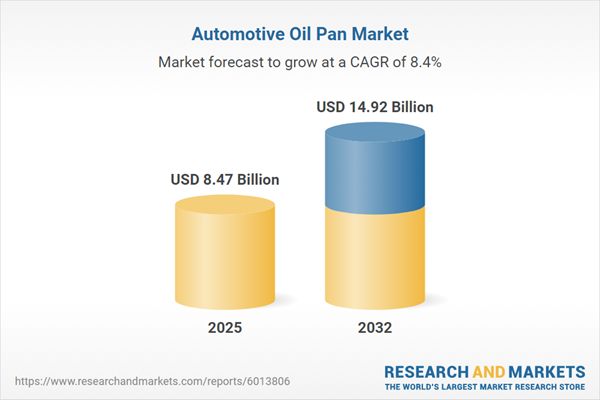Speak directly to the analyst to clarify any post sales queries you may have.
The automotive oil pan market is experiencing a significant evolution as industry leaders adapt to a dynamic landscape driven by regulatory pressures, material innovation, and supply chain complexity. Modernizing sourcing and product strategies is essential for organizations seeking to sustain growth and outperform the competition.
Market Snapshot: Automotive Oil Pan Market Size, Growth, and Dynamics
The global automotive oil pan market has shown measurable expansion, with market value increasing from USD 7.83 billion to USD 8.47 billion over the previous year. A consistent upward trajectory is supported by breakthroughs in material sciences, heightened demand for new vehicles, and integration of advanced powertrain technologies. As companies adapt to a compound annual growth rate of 8.39%, strategies increasingly emphasize efficiency, continuous product improvement, and robust supply chain integration. The competitive environment encourages both established and emerging players to realign sourcing and development priorities in response to changing engineering requirements.
Scope & Segmentation: Strategic Insights for the Automotive Oil Pan Market
This research provides targeted analysis for executive decision-making, highlighting priority areas affecting procurement, product development, and operational resilience across critical segments:
- Application Type: Original equipment manufacturer and aftermarket segments each offer specific procurement and service considerations for creating tailored solutions and supporting long-term customer relationships.
- Vehicle Category: Passenger vehicles—including sedans, SUVs, coupes, and hatchbacks—and a broad spectrum of commercial vehicles require adaptable product design and supply approaches to satisfy diverse usage and compliance needs.
- Material Choices: Assessing aluminum, composite, and steel oil pan solutions enables decision-makers to weigh cost efficiency, sustainability targets, product longevity, and evolving regulatory directives.
- Engine Technology: The need for compatibility with gasoline, diesel, and hybrid propulsion systems necessitates flexible engineering roadmaps and ongoing product innovation.
- Regional Markets: Comprehensive coverage of the Americas, Europe, Middle East, Africa, and Asia-Pacific underlines the need to address distinct regulatory standards and identify growth opportunities within and across territories.
- Leading Companies: Benchmarking against key players—such as Dana Incorporated, MAHLE GmbH, Tenneco Inc., Modine Manufacturing Company, Aisin Corporation, Magna International Inc., American Axle & Manufacturing, Inc., and Gestamp Automoción, S.A.—supports informed supplier selection and cooperative strategies.
Exploring each segment ensures stakeholders can develop precise sourcing, manufacturing, and go-to-market strategies tailored to shifting regional needs and sector advancements.
Key Takeaways for Senior Decision-Makers
- Adopting lighter, more innovative materials compels procurement and engineering teams to re-examine both core design principles and wider sustainability objectives.
- The ongoing emergence of hybrid and electric vehicle architectures presents new oil pan integration and thermal management requirements, directing an agile engineering response.
- Strategic partnerships with both original equipment and aftermarket suppliers improve supply reliability, crucial for navigating market volatility and business continuity risks.
- Advances in digital twin technology and rapid prototyping are accelerating product development cycles, supporting faster adaptation to changing requirements and shorter time-to-market.
- Regional sourcing and supplier alliances are proving essential for risk mitigation, allowing organizations to anticipate and respond effectively to geopolitical and logistical disruptions.
- Discussions around integrating smart sensors into oil pan products point toward enhanced predictive maintenance potential, especially valuable for streamlined fleet management and extended post-sale service.
Tariff Impact: Sourcing and Supply Chain Implications
Recent tariff adjustments in the United States have introduced added sourcing complexity, particularly for aluminum and steel components. Organizations are reacting by renegotiating supplier agreements, advancing domestic procurement strategies, and reinforcing close partnerships with key vendors. Agile procurement models—with greater flexibility—are now a core tool for reinforcing supply chain resilience and minimizing disruption risks throughout the automotive oil pan sector.
Methodology & Data Sources
This analysis synthesizes insights from structured interviews with procurement and engineering leaders, as well as feedback from sustainability specialists. The market overview is further supported by peer-reviewed literature and industry-standard data sets, ensuring reliability and clarity for executive strategy development.
Why This Report Matters
- Equips organizations with actionable structures to refine procurement, boost operational agility, and enhance product development in step with evolving regulatory and marketplace demands.
- Elevates risk management with dedicated guidance for navigating local and global supply chains, enabling leaders to anticipate compliance and sourcing challenges.
- Strengthens foundations for scalable growth, rooted in strategic sourcing, supplier collaboration, and ongoing innovation initiatives.
Conclusion
Success in the automotive oil pan market relies on leveraging material advances, adaptable supply networks, and the latest technologies. Informed leaders can position their organizations for longevity and growth within this rapidly shifting sector.
Additional Product Information:
- Purchase of this report includes 1 year online access with quarterly updates.
- This report can be updated on request. Please contact our Customer Experience team using the Ask a Question widget on our website.
Table of Contents
3. Executive Summary
4. Market Overview
7. Cumulative Impact of Artificial Intelligence 2025
Companies Mentioned
The companies profiled in this Automotive Oil Pan market report include:- Dana Incorporated
- MAHLE GmbH
- Tenneco Inc.
- Modine Manufacturing Company
- Aisin Corporation
- Magna International Inc.
- American Axle & Manufacturing, Inc.
- Gestamp Automoción, S.A.
Table Information
| Report Attribute | Details |
|---|---|
| No. of Pages | 192 |
| Published | November 2025 |
| Forecast Period | 2025 - 2032 |
| Estimated Market Value ( USD | $ 8.47 Billion |
| Forecasted Market Value ( USD | $ 14.92 Billion |
| Compound Annual Growth Rate | 8.3% |
| Regions Covered | Global |
| No. of Companies Mentioned | 9 |









